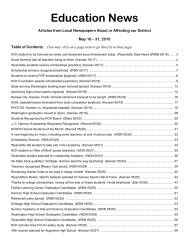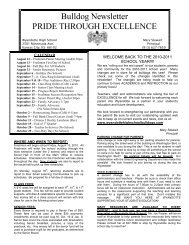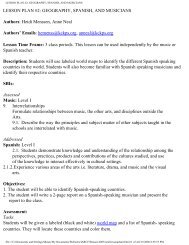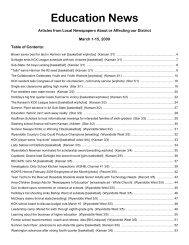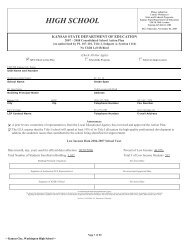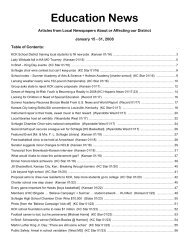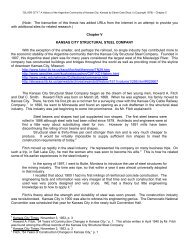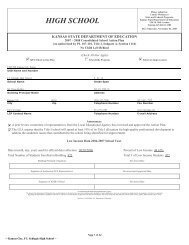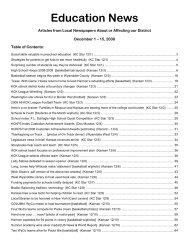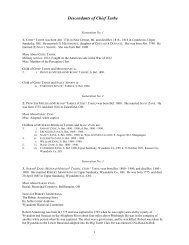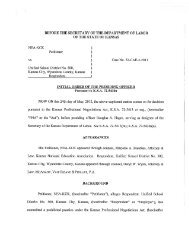Harmon - Kansas City, Kansas Public Schools
Harmon - Kansas City, Kansas Public Schools
Harmon - Kansas City, Kansas Public Schools
Create successful ePaper yourself
Turn your PDF publications into a flip-book with our unique Google optimized e-Paper software.
Disaggregated Data Graphs depicting 2007 <strong>Kansas</strong> Reading and Math Assessments-- <strong>Kansas</strong> <strong>City</strong>, J C <strong>Harmon</strong> High School --Page 6 of 40
Custom Rescue- PumperSpecificationsBidderCompliesYes NoMODEL YEARThe chassis shall have a vehicle identification number that reflects a 2009 model year.COUNTRY OF SERVICEThe chassis shall be put in service in the country of United States of America (USA).APPARATUS TYPEThe cab and chassis shall include design considerations for multiple emergency vehicle applications,rapid transit and maneuverability. The chassis shall be manufactured for heavy duty service with thestrength and capacity to support a fully laden apparatus, one hundred (100) percent of the time.APPARATUS TYPEThe apparatus shall be a pumper vehicle designed for emergency service use which shall beequipped with a permanently mounted fire pump which has a minimum rated capacity of 750 gallonsper minute (3000 L/min). The apparatus shall include a water tank and hose body whose primarypurpose is to combat structural and associated fires.VEHICLE TYPEThe chassis shall be manufactured for use as a straight truck type vehicle and designed for theinstallation of a permanently mounted apparatus behind the cab. The apparatus of the vehicle shallbe supplied and installed by the apparatus manufacturer.AXLE CONFIGURATIONThe chassis shall feature a 4 X 2 axle configuration consisting of a single rear drive axle with a singlefront steer axle.GROSS AXLE WEIGHT RATINGS FRONTThe front gross axle weight rating (GAWR) of the chassis shall be 20,000 pounds.This front gross axle weight rating shall be adequate to carry the weight of the completed apparatusincluding all equipment and personnel.GROSS AXLE WEIGHT RATINGS REARThe rear gross axle weight rating (GAWR) of the chassis shall be 27,000 pounds.This rear gross axle weight rating shall be adequate to carry the weight of the completed apparatusincluding all equipment and personnel.CAB STYLEThe cab shall be a custom, enclosed model, built specifically for the fire service by a companyspecializing in cab and chassis design for all fire service applications.Page 7
<strong>Harmon</strong> High SchoolPercent of Students At or Above Proficiencyon <strong>Kansas</strong> Reading AssessmentNew KS assessmentimplemented at this 100.0time.90.02002 2003 2004 2005 2006 2007AYP Goal 44.0 44.0 51.0 58.0 58.0 65.0F&R 20.4 35.4 42.0 42.6 41.7 39.3103 99 124 181 163 168Paid 21.8 29.8 45.2 37.9 50.0 48.978 67 51 66 60 45ELL 64.3 75.0 75.8 61.6 16.2 2.914 16 29 47 43 34Disabled 0.0 28.6 43.8 52.4 70.3 33.317 21 16 42 32 24Migrant 58.4 56.312 16White 23.1 33.4 61.3 52.9 52.1 51.152 60 31 51 46 47Black 17.6 22.2 38.1 32.3 52.5 43.951 36 42 68 59 57Asian 7.1 18.2 33.314 11 10Hispanic 24.2 36.3 41.6 42.7 31.8 36.662 58 84 110 91 101Male 19.6 34.5 50.0 47.6 44.7 44.897 81 72 128 127 116Female 22.9 31.7 38.2 34.4 52.6 37.183 85 102 119 112 97School Total 21.0 33.1 42.9 41.3 42.9 41.3Number Tested 181 166 175 247 207 213Student Gro oupsSmall font numbers for each group indicate group size.Results are not reported for student groups smaller than 10 members.80.070.060.050.040.030.020.010.00.02002 2003 2004 2005 2006 2007AYP Goal F&R PaidELL Disabled MigrantWhite Black AsianHispanic Male FemaleSchool TotalPage 8 of 40
-- <strong>Kansas</strong> <strong>City</strong>, J C <strong>Harmon</strong> High School --Page 9 of 40
-- <strong>Kansas</strong> <strong>City</strong>, J C <strong>Harmon</strong> High School --Page 10 of 40
<strong>Harmon</strong> High SchoolPercent of Students At or Above Proficiencyon <strong>Kansas</strong> Math AssessmentNew KS assessmentimplemented at this 100.0time.90.02002 2003 2004 2005 2006 2007AYP Goal 29.1 29.1 38.0 46.8 46.8 55.7F&R 7.3 13.7 9.3 18.5 11.6 26.4123 160 214 211 206 182Paid 12.5 16.5 4.5 11.4 17.4 28.056 67 67 44 73 50ELL 4.0 2.0 0.0 19.7 12.5 35.725 49 53 61 48 42Disabled 0.0 21.7 14.3 40.5 3.0 28.110 46 42 42 33 32Migrant 0.0 0.0 13.012 13 23White 12.5 22.2 10.6 16.8 14.7 32.756 45 66 54 68 55Black 11.9 11.1 8.9 21.7 11.7 21.142 36 68 74 68 57Asian 0.0 15.4 30.0 9.012 13 10 11Hispanic 4.2 12.6 6.8 14.8 13.4 26.472 71 117 108 119 110Male 11.0 17.0 10.6 13.0 21.6 32.891 106 141 139 152 128Female 6.8 12.4 5.7 22.3 9.6 19.288 121 140 116 158 104School Total 8.9 14.6 8.2 17.3 13.0 26.7Number Tested 179 227 281 255 269 232Student Gro oupsSmall font numbers for each group indicate group size.Results are not reported for student groups smaller than 10 members.80.070.060.050.040.030.020.010.00.02002 2003 2004 2005 2006 2007AYP Goal F&R PaidELL Disabled MigrantWhite Black AsianHispanic Male FemaleSchool TotalPage 11 of 40
<strong>Kansas</strong> <strong>City</strong>, <strong>Kansas</strong> School Improvement PlanSchool J C <strong>Harmon</strong> High SchoolReadingII. Data Disaggregation by DemographicsGroups% at AcademicWarning% at ApproachesStandardState Assessment% at MeetsStandard% at ExceedsStandard% at ExemplaryLocal Assessment% at Proficient oraboveAll Students 23 35.68 26.76 10.32 4.22 23.1Caucasion 8.51 40.42 29.78 14.89 6.38 42.3African American 19.29 36.84 24.56 14.03 5.26 18.5Hispanic 31.68 31.68 26.73 6.93 2.97 20.9AsianAmerican IndianMale 25.86 29.31 25.86 12.06 6.89 24.7Female 19.58 43.29 27.83 8.24 1.03 21.1Free/Reduced 23.80 36.90 25.59 10.11 3.57 20.8Paid 35.3SPED 20.83 45.83 8.33 12.50 12.50 15.0ESL 55.88 41.17 2.94 0 0 5.4MigrantData Disaggregation by Grade Level (all which apply to this building)Grade% at AcademicWarning% at ApproachesStandardState Assessment% at MeetsStandard% at ExceedsStandard% at ExemplaryLocal Assessment% at Proficient orabove9 21.710 22.011 23 35.68 26.76 10.32 4.22 28.112 26.1-- <strong>Kansas</strong> <strong>City</strong>, J C <strong>Harmon</strong> High School --Page 12 of 40
II. Data Disaggregation by Demographics -- continued --Based on the site data, identify your building Reading GoalA minimum of 72.0% of the whole population and each of the subgroups will perform at least at the proficiency level or show gainsto make safe harbor or the confidence levels on the <strong>Kansas</strong> State Reading Assessment.A minimum of 72.0% of all Free and Reduced Lunch students will perform at least at the proficiency level or show gains to makesafe harbor or the confidence levels on the <strong>Kansas</strong> State Reading Assessment.A minimum of 72.0% of the English Language Learners will perform at least at the proficiency level or show gains to make safeharbor or the confidence levels on the <strong>Kansas</strong> State Reading Assessment.A minimum of 72.0% of all African American Students will perform at least at the proficiency level or show gains to make safeharbor or the confidence levels on the <strong>Kansas</strong> State Reading Assessment.A minimum of 72.0% of all Hispanic students will perform at least at the proficiency level or show gains to make safe harbor orthe confidence levels on the <strong>Kansas</strong> State Reading Assessment.Identify the relevant State Standards and Indicators the site will focus on based on the building Reading Goal<strong>Kansas</strong> State Assessed Indicators:R1.3.1 - Vocabulary in ContextR1.3.3 - Structural Analysis (roots, suffixes, prefixes)R1.3.4 - Figurative Language: simile, metaphor, analogy, hyperbole, onomatopoeia, personification, idiom, imageryR1.4.2 - Text Features (headings, titles, illustrations, sidebars)R1.4.5 - Inferences/ConclusionsR1.4.6 - Text Structure (description, sequence, problem/solution, comparison/contrast, cause/effect)R1.4.7 - Compare/ContrastR1.4.8 - Cause/EffectR1.4.9 - Paraphrase and SummarizeR1.4.10 - Topic, Main Idea, Supporting Details, ThemeR1.4.11 - Author's Purpose (persuade, entertain, inform) Author's use of literary devices: foreshadowing, flashback, ironyR1.4.14 - Author's Position and Persuasive Text (bandwagon, glittering generalities, testimonials, citing statistics)R1.4.15 - Fact/Opinion, recognizing propaganda, bias, and stereotypesR2.1.1 - CharactersR2.1.2 - SettingR2.1.3 - Story Elements-- <strong>Kansas</strong> <strong>City</strong>, J C <strong>Harmon</strong> High School --Page 13 of 40
Reading Targets based on the <strong>Kansas</strong> <strong>City</strong>, <strong>Kansas</strong> Literacy Model (based on data analysis check no more than two targetedstrategies)A. Phonological/Phonemic AwarenessB. Phonics InstructionC. VocabularyWe will improve Vocabulary skills for the following tiers (check all that apply)gfedcb All Studentsgfedc Some Studentsgfedc Few Studentsgfedcb Gendergfedcb African Americansgfedcb SESgfedcb Hispanicsgfedcb ELLgfedcb Whitesgfedcb SPEDgfedcb Asian Pacific Islandersgfedcb American Indiansgfedcb Mulit-Ethnic and Undeclaredgfedc K gfedc 1 gfedc 2 gfedc 3 gfedc 4 gfedc 5 gfedc 6 gfedc 7 gfedc 8 gfedcb 9 gfedcb 10 gfedcb 11 gfedcb 12The student will improve Vocabulary skills through scaffolded instruction using:Strategy Research Resources Person ResponsibleActive Engagement Egawa, K. & Harste, J. C..(October 2001). Balancing the literacycurriculum: A new vision. . SchoolTalk, (7)1), 1-8Gillet. J. W., & Temple, C. (1982). UnderstandingReading Problems: Assessment and Instruction.Boston: Little, BrownLiteracy First Training with Marzano and BuehlAllen, J..(1999). Words, Words,Words: TeachingVocabulary in Grades 4 –12. Portland, ME.Stenhouse <strong>Public</strong>ations..Beers, K..(2003). When Kids Can’tRead: What Teachers CanDo. Portsmouth, NH,Heinemann.Blachowicz, C. and Fisher, P..(2002). TeachingVocabulary in AllClassrooms. Upper SaddleRiver, NJ. Merrill PrenticeHall..Kagan, S..(1998). CooperativeLearning. San JuanCapistrano, CA: Resourcesfor Teachers, Inc..Wilhelm, J..(2001). ImprovingComprehension with ThinkAloud Strategies: ModelingWhat Good Readers Do.New York, ScholasticBooks.Mr. Roel QuintanillaMs. Kelli LortonMs. Venita ThurmanMr. Norm SedilloMr. Larry BarnesMrs. Margie RamirezSLC Team LeadersInstructional Materials: ClassroomStrategies for Interactive Learning byBuehl and Words, Words, Words, byAllen Time: Wednesday afternoonsfor staff development and SLCcommon plan time for focuseddiscussions Substitute for peercoaching, inservice times, coteaching,etc.-- <strong>Kansas</strong> <strong>City</strong>, J C <strong>Harmon</strong> High School --Page 14 of 40
D. FluencyE. ComprehensionWe will improve Comprehension skills for the following tiers (check all that apply)gfedcb All Studentsgfedc Some Studentsgfedc Few Studentsgfedcb Gendergfedcb African Americansgfedcb SESgfedcb Hispanicsgfedcb ELLgfedcb Whitesgfedcb SPEDgfedcb Asian Pacific Islandersgfedcb American Indiansgfedcb Mulit-Ethnic and Undeclaredgfedc K gfedc 1 gfedc 2 gfedc 3 gfedc 4 gfedc 5 gfedc 6 gfedc 7 gfedc 8 gfedcb 9 gfedcb 10 gfedcb 11 gfedcb 12The student will improve Comprehension skills through scaffolded instruction using:Strategy Research Resources Person ResponsibleAccessing PriorKnowledgeHerber, H..(1978). Teaching reading in content areas(2nd ed) Englewood Cliffs, NJ: Prentice-Hall.Beers, K..(2003). When Kids Can’tRead: What Teachers CanDo. Portsmouth, NH,Heinemann.Buehl, D..(2001). ClassroomStrategies for InteractiveLearning.Newark, DE:International ReadingAssociation.Marzano, R..(2004). BuildingBackground Knowledge forAcademic Achievement.Alexandria, VA. ASCD.Robb, L..(2003). Teaching Readingin Social Studies, Science,and Math. New York:Scholastic\.Zwiers, J.(2004). Building ReadingComprehension Habits inGrades 6-12: A Toolkit ofClassroom Activities.Newark, DE, InternationalReading Association..Mr. Roel QuintanillaMs. Kelli LortonMs. Venita ThurmanMr. Norm SedilloMr. Larry BarnesMrs. Margie RamirezSLC Team LeadersInstructional Materials: ClassroomStrategies for Interactive Learning byBuehl and Words, Words, Words byAllen Time: Wednesday afternoonsfor staff development and SLCcommon plan time for focusedconversations Substitutes for peercoaching, co-teaching, staffdevelopment, etc-- <strong>Kansas</strong> <strong>City</strong>, J C <strong>Harmon</strong> High School --Page 15 of 40
F. MotivationG. OtherSCIENTIFICALLY BASED RESEARCH for ReadingDescribe how the selected strategies are supported by scientifically based reading research to address your targeted student needs.The selected strategies represent current scientific based research in the field of literacy. They reflect the dimensions of reading as outlined bythe National Reading Panel report. These strategies are effective with all students as reported by the National Reading Panel. Therefore, theselected strategies address the targeted student needs.-- <strong>Kansas</strong> <strong>City</strong>, J C <strong>Harmon</strong> High School --Page 16 of 40
Formative Assessments for ReadingFor each target selected, identify the formative assessments that will be used to monitor effectiveness and success of strategy.TargetFormative AssessmentA.Phonological/PhonemicAwarenessB. PhonicsC. Vocabulary ACT Plan(10th grade), NWEA MAP(9th-11th grades) and <strong>Kansas</strong> Reading Assessment(10th & 11th grade)D. FluencyE. Comprehension Reading Enhancement Classes(9th grade), ACT Plan(10th grade), NWEA MAP(9th -11th grades) and<strong>Kansas</strong> Reading Assessment(10th & 11th grade)F. MotivationG. OtherResults-Based Staff Development Plan For Reading(Complete for each target selected)Knowledge LevelActivities (for example:workshops, study groups,classes, professionalreading)A.Phonological/PhonemicAwarenessB. PhonicsStaff will study andC. Vocabularyuse Literacy Firststrategies and discussthe Word Wall, WordSplash, Concept Maps,Frayer Model, andData Sets vocabularystrategies that we willfocus on as an entirestaffD. FluencyTeachers will discussE. Comprehensionthe importance of priorknowledge tounderstanding andcomprehending theirreading.-- <strong>Kansas</strong> <strong>City</strong>, J C <strong>Harmon</strong> High School --Modeling and/orDemonstration Activities(for example: jobembeddedsample lessons,observations)Practice with FeedbackActivities (for example,job-embedded walk-thru,peer observations andconferences)Follow-up Activities(for example, jobembeddedstudyingstudent work, dataanalysis)Dates Dates Dates Datesentire yearentire yearThe readingcommittee, EnglishTeachers, MathTeachers, and LiteracyFirst consultants willmodel and provideexamples usingcontent vocabulary andconcepts for teacherswithin their contentarea groups.EnglishTeachers,Literacy Firstconsultants, andReading Committeewill provide examplesof accession priorknowledge strategiesutilizing informationfrom Doug Buehl andJanet Allen.Page 17 of 40entire yearentire yearTeachers model anduse vocabularystrategies to teachcontent vocabulary andconcepts weekly.Through guidedpractice student willtake moreresponsibility for usingthe strategies until theycan independentlyapply them to a word.Vocabulary should bevisable upon walkinginto the classroom.Teachers model anduse strategies in preandduring readingactivities to aid incomprehension ofvarious texts at leastonce per quarter.entire yearentire yearTeachers are providedtime to discuss thesuccesses and failuresof these vocabularystrategies in order tocreate supportnetworks. Duringentire school staffdevelopment, SLCswill be responsibility(on a rotatingschedule) to discuss aparticular strategyandhow it worked, ordidn't. There should bea regular conversationaround student workusing these strategieswithin SLC commonplan time.Teachers are providedtime to discuss thesuccesses and failuresof this vocabularystrategy in order tocreate supportnetworks. Duringentire school staffdevelopment, SLCswill be responsibility(on a rotatingschedule) to discuss aparticular strategy andhow it worked, ordidn't. There should bea regular conversationentireyearentireyear
around student workusing these strategieswithin SLC commonplan time.F. MotivationG. OtherStaff DevelopmentResources Neededinstructional materials,time,personnelinstructional materials,time,personnelsubstitutes, timetime, personnel-- <strong>Kansas</strong> <strong>City</strong>, J C <strong>Harmon</strong> High School --Page 18 of 40
<strong>Kansas</strong> <strong>City</strong>, <strong>Kansas</strong> School Improvement PlanSchool J C <strong>Harmon</strong> High SchoolMathematicsIII. Data Disaggregation by DemographicsGroups% at AcademicWarning% at ApproachesStandardState Assessment% at MeetsStandard% at ExceedsStandard% at ExemplaryLocal Assessment% at Proficient oraboveAll Students 47.84 25.43 18.10 5.60 3.01 16.1Caucasion 32.72 34.54 20.00 7.27 5.45 23.6African American 50.87 28.07 12.28 3.50 5.26 15.8Hispanic 52.72 20.90 19.09 6.36 0.90 13.9Asian 18.2American IndianMale 42.18 25.00 18.75 9.37 4.68 19.8Female 54.80 25.96 17.30 0.96 0.96 11.7Free/Reduced 49.45 24.17 18.13 4.39 3.84 16.0Paid 16.9SPED 40.62 31.25 0 9.37 18.75 2.7ESL 45.23 19.04 28.57 7.14 0 4.3MigrantData Disaggregation by Grade Level (all which apply to this building)Grade% at AcademicWarning% at ApproachesStandardState Assessment% at MeetsStandard% at ExceedsStandard% at ExemplaryLocal Assessment% at Proficient orabove9 19.410 13.911 47.84 25.43 18.10 5.60 3.01 7.712-- <strong>Kansas</strong> <strong>City</strong>, J C <strong>Harmon</strong> High School --Page 19 of 40
III. Data Disaggregation by Demographics -- continued --Based on the site data, identify your building Mathematics GoalA minimum of 64.6% of the whole population and each of the subgroups will perform at least at the proficiency level or show gains tomake safe harbor or the confidence levels on the <strong>Kansas</strong> State Mathematics Assessment.A minimum of 64.6% of the English Language Learners will perform at least at the proficiency level or show gains to make safe harbor orthe confidence levels on the <strong>Kansas</strong> State Mathematics Assessment.Identify the relevant State Standards and Indicators the site will focus on based on the building MathematicsGoalJ.C. <strong>Harmon</strong> will focus on the following state assessed indicators:Standard 1.2.K3 Number - Number Systems - Property KnowledgeStandard 1.3.A1 Number - Estimation - Real World EstimationStandatd 1.4.A1 Number - Computation - Formula Applications Standard 2.2.K3 Algebra - Variables - Systems of equations KnowledgeStandard 2.2.A2 Algebra - Variables - Linear Equations and Inequalitities ApplicationsStandard 2.3.K6 Algebra - Functions - Knowledge of Graphs of Linear FunctionsStandard 2.3.A2 Algebra - Functions - Analysis of Real World Linear Function ApplicationsStandard 3.1.A1 Geometry - Figures - Applications of the Pythagorean TheoremStandard 3.3.A1 Geometry - Transformational - Analysis of Changes Made to Perimeter, Area, and VolumeStandard 3.4.K4 Geometry - Algebraic Perspective - Equations of Parallel and Perpendicular LinesStandard 3.4.K6 Geometry - Algebraic Perspective - Changing Linear Equations to Slope-Intercept FormStandard 4.1.K3 Data - Probability - Probability and OddsStandard 4.2.K4 Data - Statistics - Effects of OutliersStandard 4.2.K5 Data - Statistics - Line of Best FitStandard 4.2.A1 Data - Statistics - Data Analysis-- <strong>Kansas</strong> <strong>City</strong>, J C <strong>Harmon</strong> High School --Page 20 of 40
Mathematics Targets based on the <strong>Kansas</strong> <strong>City</strong>, <strong>Kansas</strong> Mathematics Model(based on data analysis check no more than two targeted strategies)A. Conceptual Understanding; Computational and Procedural Fluency; Strategic Competence (Problem Solving); AdaptiveReasoning; Positive, Production DispositionWe will improve Conceptual Understanding; Computational and Procedural Fluency; Strategic Competence (Problem Solving);Adaptive Reasoning; Positive, Production Disposition skills for the following tiers (check all that apply)gfedc All Studentsgfedc Some Studentsgfedc Few Studentsgfedc Gendergfedc African Americansgfedc SESgfedc Hispanicsgfedc ELLgfedc Whitesgfedc SPEDgfedc Asian Pacific Islandersgfedc American Indiansgfedc Mulit-Ethnic and Undeclaredgfedc K gfedc 1 gfedc 2 gfedc 3 gfedc 4 gfedc 5 gfedc 6 gfedc 7 gfedc 8 gfedc 9 gfedc 10 gfedc 11 gfedc 12The student will improve Conceptual Understanding; Computational and Procedural Fluency; Strategic Competence (ProblemSolving); Adaptive Reasoning; Positive, Production Disposition skills through scaffolded instruction using:Strategy Research Resources Person ResponsibleVocabularyAcquisitionBaker, S.K., Simons, D.C. & Kameenui, E.J..(1995). Vocabulary acquisition: Synthesisof the research. Eugene, OR: Universityof Oregon, . Technical Report, No. 13),Kilpatrick, J., Swafford, J., & Findell, B. (Eds.).(2001). Adding it up: Helping childrenlearn mathematics. Washington, DC:Mathematics Learning Study Committee,Center for Education, Division ofBehavioral and Social Sciences andEducation, National Academy Press..Monroe, E. E. .(1998). Using graphic organizers to teachvocabulary: Does available researchinform mathematics instruction? .Usiskin, Z..(1996). Communication in mathematics,K – 12 and beyond (1996 Yearbook).Reston, VA: National Council ofTeachers of Mathematics..Barton, M.L., & Heidema, C..(2002). Teaching reading inmathematics, (2nd ed.).Aurora, CO: Mid-continentResearch for Education andLearning..Murray, M..(2004). Teachingmathematics vocabulary incontext. Portsmouth, NH:Heinemann..Readence, J.E., Bean, T.W., &Baldwin, R.S..(2001). Content arealiteracy: An integratedapproach, (7th ed.).Dubuque, IA: KendallHunt..Instructional Materials Time:Wednesday afternoons for staffdevelopment and SLC common plantime for focused conversationsSubstitutes for peer coaching, coteaching,staff development, etc.PrincipalAssistant PrincipalsICsEnglish TeachersMath TeachersNCA Problem Solving CommitteeSLC teams-- <strong>Kansas</strong> <strong>City</strong>, J C <strong>Harmon</strong> High School --Page 21 of 40
G. OtherSCIENTIFICALLY BASED RESEARCH for MathematicsDescribe how the selected strategies are supported by scientifically based research to address your targeted student needs.The selected strategies represent current scientific based research in the field of mathematics. They reflect the fivestrands of mathematical proficiency as outlined by the National Research Council. These strategies are effective withall students as reported by the National Research Council. Therefore, the selected strategies address the targeted studentneeds.-- <strong>Kansas</strong> <strong>City</strong>, J C <strong>Harmon</strong> High School --Page 22 of 40
Formative Assessments for MathematicsFor each target selected, identify the formative assessments that will be used to monitor effectiveness and success of strategy.TargetA. ConceptualUnderstanding,Computational andProcedural Fluency,Strategic Competence(Problem Solving),Adaptive Reasoning,Postive, ProductiveReasoningB. OtherFormative AssessmentLocal Assessment - NWEA MAP(9th - 12th), ACT Plan (10th), Benchmark AssessmentAlgebra/Geometry 1, 2, and 3, Informal classroom observations and evaluations, State assessmentsused as diagnosticsResults-Based Staff Development Plan For Mathematics(Complete for each target selected)A. Conceptual Understanding,Computational and Procedural Fluency,Strategic Competence(Problem Solving),Adaptive Reasoning,Postive, Productive ReasoningB. OtherStaff Development Resources NeededKnowledge LevelActivities (forexample:workshops, studygroups, classes,professionalreading)Content teammeetings, studygroup, graduateclass, SLCcollaborativeplanning,professionalreadingsModeling and/orDemonstrationActivities (forexample: jobembeddedsamplelessons,observations)Practice withFeedbackActivities (forexample, jobembeddedwalkthru,peerobservations andconferences)Follow-upActivities (forexample, jobembeddedstudying studentwork, dataanalysis)Dates Dates Dates Datesentire yearinstructional materials,time,personnelProblem SolvingCommittee work,Wed. Inservicemodeling, SLCmeetings, samplelessonsinstructional materials,time,personnelentire yearContent Teammeetings,Peer/Leadershipteam walkthroughs,observations andconferencessubstitutes, timeentire yearData Analysis,student worktime, personnelentireyear-- <strong>Kansas</strong> <strong>City</strong>, J C <strong>Harmon</strong> High School --Page 23 of 40
Describe what your school will implement to support the identified teaching and learningneeds of students in each content area to bring about increased academicachievement.Multi-Tiered System of Supports (MTSS)RtIThird TierIntensive SupportSecond TierDifferentiated – Flexible GroupFirst TierHigh Quality – Whole Group5 – 10%20 – 30%100%RESEARCHBureau of Exceptional Education and Student Services: Florida Department ofEducation. (2006). The response to intervention (RtI) model (Technicalassistance paper No. 12740). Tallahassee, FL.Christ, T. J., Burns, M. K., & Ysseldyke, J. E. (2005). Conceptual confusion withinresponse-to-intervention vernacular: Clarifying meaningful differences. NASPCommuniqué, 34 (3), 1-8.Denton, C. A. (Ed.). (2006, Winter). Responsiveness to Intervention as an Indication ofLearning Disability [Theme Issue]. Perspectives. 32(1).Fletcher, J. M., Lyon, G.R., Fuchs, L..S., & Barnes, M.A. (2007). Learning disabilities:From identification to intervention. New York: Guilford Press.Jimerson, Shane R.; Burns, Matthew K.; VanDerHeyden, Amanda (Eds.) (2007).Handbook of response to intervention: The science and practice of assessmentand intervention. New York: Springer.National Association of State Directors of Special Education (2005). Response tointervention: Policy considerations and implementationWalpole, Sharon; McKenna, Michael C., Differentiated Reading Instruction Strategiesfor Primary Grades, 2007. The Guilford Press, NY-- <strong>Kansas</strong> <strong>City</strong>, J C <strong>Harmon</strong> High School --Page 24 of 40
Tier 1Whole class instructionStrategies based on: Phonological/Phonemic Awareness (Elementary only)Phonics Instruction (Elementary only)See sectionVocabularyon ReadingFluencyStrategiesComprehensionMotivation (Elementary only)Strategies based on: Conceptual Understanding; Computational and ProceduralSee sectionon MathStrategiesFluency; Strategic Competence (Problem Solving);Adaptive Reasoning; Positive, Production DispositionTier 2More Time:Tutoring: After School, Saturday School, Before School, During LunchBenchmark Recovery – Additional time for students struggling inpassing their benchmarksDouble DipPull Outs – from student elective periods and teacher planning timeSystematic Instruction in Phoneme Awareness, Phonics, and Sight words (SIPPS)Read 180Differentiated InstructionFlexible groupingReading & Math Achievers – students who are at proficient plus percentage of studentsapproaching standardsOutside consultants to set goals and expectations with Leadership team – Reading &Math. Consultants recommend specific strategies to improve effectiveness ofinstructionAdvocates in constant touch with parents on student progressTier 3Individualized InstructionSame tutoring opportunities as Tier 2Differentiated InstructionIn addition to Tier 1Assessment basedIntensive all day tutoring to selected students who need additional practice (monthly)Many of the items listed in Tier 2 are also used as Tier 3SPED services – for students who qualify-- <strong>Kansas</strong> <strong>City</strong>, J C <strong>Harmon</strong> High School --Page 25 of 40
V. PROFESSIONAL DEVELOPMENT FOR SCIENTIFICALLY BASED RESEARCHSTRATEGIES WITH TIME LINEDescribe the high quality and ongoing professional development that will support the schoolwide reform strategiesThe administration, ICs, and SLC coordinators will work together as the professional development team. They will meetweekly to review and set agendas for the SLC Wednesday early-release in-service time. Professional development will bedriven by the SIP, Literacy First Training, and needs of the SLCs. District inservice and Content Wednesdays will supportprofessional development and build a culture of problem solving/math and literacy. The IC's will provide ongoing supportand professional development for new and existing staff.Describe how the plan is integrated with the school’s results-based staff development plan, including a timelineThe student strategies that have been selected will occur ongoing throughout the year across the curriculum. End-ofunit/benchmarkdiagnostics will create opportunities for teaching and/or reteaching so that students successfully completethe units. LiteracyFirst training will take place throughout the year with a focus across the curriculum. Graduate classes at the district leveland building study groups will support study and practice in the areas of literacy and problem solving. The Math andEnglish departments will meet weekly. We will utilize peer walk throughs with learning focused conversations to push ourthinking and development. The SLCs will collaboratively and collectively come together to provide enhanced learning andfocus on the strategies for improving student performance. By using designs and strategies for staff development thatmatch the intended learning goals of the students, the staff will improve instructional practices. SLCs will use data fromvarious sources for professional development. Weekly support for IC's will support the school improvement efforts in thebuilding. Collaborative work with outside consultatnts in math and reading will provide support for implementation andreflective thinking on the work and stratgeies.Describe how professional development resources will be sufficient to effectively carry out the schoolwide reformstrategiesOngoing support from the building and district will be critical in carrying out schoolwide reform. Support for Math andReading consultants,graduate tuition for math content classes, Literacy First consultants, IC's, and professionaldevelopment are necessary.Describe the research behind the scientifically based strategies used by the staff.We have adhered to the National Staff Development Council's (NSDC) standards when planning and implementing ourstaff development. An annotated bibliography provides scientifically based research about each standard for professionaldevelopment (www.nsdc.org). Our goal is based on the NSDC goal that states..."all teachers in (our) schools willexperience high-quality professional learning as part of their daily work by":-working in learning teams or communities.-having effective leadership: staff development is job-embedded, coming from all ranks of the schools; principals andinstructional coaches as instructional leaders to achieve school and district goals and to engage parents and communitymembers.-using data from various sources for important staff development purposes.-using evaluation that informs staff development and is based on multiple sources of information to guide improvementand demonstrate its impact on student achievement.-becoming informed consumers of educational research when selecting both the content and professional learningprocesses used in staff development efforts.-using designs and strategies for staff development that match the intended learning goals of students.-collaboratively working to improve the learning of all students; collectively responsible for staff development that meetsthe intended goals of students.-providing staff development that helps teachers understand the general cognitive, social/emotional, and backgrounds ofstudents in our classrooms (which may be different than our own).Describe how teachers will use academic assessments to provide information for improved instructional practices forsupporting individual student achievement.-- <strong>Kansas</strong> <strong>City</strong>, J C <strong>Harmon</strong> High School --Page 26 of 40
The staff will come together to provide enhanced learning and student performance on the assessments in the areas ofliteracy and problem solving. All assessments will be reviewed and studied by the staff through the content teams andSLCs. Teachers will share ideas and have conversations about the students and content taught in the SLCs and in thecontent teams. The study group approach will provide opportunities for review, study, practice and reflection on researchbasedstrategies that support literacy and problem solving.Describe the school’s teacher-mentoring program. Include written policies and guidelines that specifically address howthe teacher-mentoring program focuses on scientifically based research strategies related to reading* and/ormathematics.*Each new teacher to the building is assigned a buddy or mentor depending on the number of years that the new person hastaught. The beginning teachers are paired with mentors that facilitate reflective teaching. The buddy teachers help newexperienced teachers get oriented to the building and procedures. Orientation for new teachers will take place beforeschool starts.The purpose of the <strong>Kansas</strong> <strong>City</strong>, <strong>Kansas</strong> mentoring program is to provide beginning teachers with asupportive, formative process designed to assist their growth as reflective practitioners. The programis both structured and flexible, and consists of a series of strategies focused on the process ofteaching. Designed for beginning teachers with the assistance of trained mentors, the program isground in a developmental view of learning to teach.The program combines three essential elements for developing and sustaining teacher quality insupport of student learning: a common language for talking about and assessing teaching; clear andconcrete levels of performance for teachers to use in assessing themselves; and structured eventsthrough which beginning teachers can develop or hone their skills.The <strong>Kansas</strong> <strong>City</strong>, <strong>Kansas</strong> mentor program is based on the ASK, Inc. mentoring Program developedby Paula Rutherford. Two books will be used by the rookies. Why Didn’t I Learn this in College?and Instruction for All Students. A third book Mentoring in the 21st Century will be used by thementors, instructional coaches and administrators.The <strong>Kansas</strong> <strong>City</strong> <strong>Kansas</strong> mentoring program is built on five goals:Beginning teachers will work with a mentor to develop or enhance teaching skills. A log sheetis turned in at every meeting specifying the topics and time spent in collaboration. TheCoordinator of Induction makes a minimum visit to the schools (48 in total) twice a semester toobserve the progress and have individual conversation with the pair to determine progress.Beginning teachers will acquire knowledge necessary to become familiar with the district,school, and community. An orientation to the district is given the firt two duty days (theircontract is extended two days) offering classes areas unique to our district and community. Theguided reading as it is done in primary grades, teaching to diverse students, First Things Firstand how our district does business, computer systems unique to our schools, and BISTdiscipline procedures.Beginning teachers will participate in monthly professional development meetings to enhanceand improve skills effective teaching skills. The beginning teachers are required to attendmeetings each month to reflect and learn teaching techniques helping them to become betterinstructors and caring advocates for their students.Beginning teachers and their mentor will develop and enhance professional and workingrelationships. Our mentors and beginning teachers are asked to spend a minimum of one hourweekly in collaborative conversation. They keep a log of topics and time spent. The log isturned in at each of the beginning teacher after school meetings.Mentors will develop and enhance skills necessary to provide professional and personalassistance for their beginning teacher. Because the beginning teachers have a major part toplay in the selection of his/her mentor, relationships start from the first day of the year. Thementors have provided guidance and direction voluntarily before they were even chosen. Asthe relationship develops and conversations between the two teachers become more focused on-- <strong>Kansas</strong> <strong>City</strong>, J C <strong>Harmon</strong> High School --Page 27 of 40
classroom success, the mentors will have opportunity to evaluate their own teaching practices.The mentors have the same program books as the beginning teacher and together they canstudy the area topic for the month and reflect on the results of the new teaching from thebeginning teacher.The program involves several distinct types of structure topics, with activities assigned monthly asaddressed during after school in-services. Attendances at monthly meetings are mandatory.The topics addressed are designed to increase the comfort and teaching skills within the classroom.There are a total of seven topics required for the beginning teacher to explore and add to theirprofessional “tool belt.” The mentor teacher becomes the source of encouragement, reflection, andcoaching for their success by monthly observations in the beginning teacher’s classroom.Basic criteria established for mentor selection meet the standards developed by the State Board ofEducation. Mentors must be licensed with at least three consecutive years teaching with the district.Participation is voluntary.Each topic enables beginning teachers to explore different aspects of their practice and to becomeincreasingly proficient in the components of professional practice. The topics require theparticipation of both beginning teachers and their mentors, thereby encouraging professionalcollaboration and growth for both teachers.The syllabus for the training of mentors and administrators include all of the following components:Developmental stages of the new teacherRoles and responsibilities of the mentorCoaching, observation and feedbackRelationship buildingCollaborationConfidentiality* In order to comply with ESEA, scientifically based research strategies must be derived from the five components of reading from the Center for the Improvement of Early ReadingAchievement (CIERA) and the National Institute for Literacy, drawn from the 2000 report of the National Reading Panel. Scientifically based research strategies for mathematics should reflectthe five strands of mathematics from the National Research Council, Helping Children Learn Mathematics and Adding It Up.-- <strong>Kansas</strong> <strong>City</strong>, J C <strong>Harmon</strong> High School --Page 28 of 40
VI. HIGHLY QUALIFIED STAFFHow will the school ensure instruction by highly qualified teachers?Teachers in the district are required to attend district wide training each quarter. Training involves the implementation ofdistrict-mandated programs. For the middle school, the math department focuses on best practices for teaching ConnectedMath and the reading department focuses on best practices for teaching Read 180, Read XL, and High Point. All of theother departments provide support for learning strategies used standards based lessons. All teachers will meet the stateand NCLB definition of Highly Qualified or will have a plan on file at the Professional Development office on how andwhen they will fulfill that requirement. Teachers who are teaching in an unendorsed area will also file a plan with theProfessional Development office on how and when they meet those requirementsOther:At the high school, the math department focuses on best practices for teaching the standards-based curriculum(benchmarks) using various resources, and the English department focuses on best practices for teaching readingcomprehension.Describe strategies used to attract highly qualified teachersThe district initiative to First Things First is a major attraction for attracting highly qualified teachers. Lowering pupil /teacher ratio through Title I allows for smaller class sizes. Continuity of care allows the teacher to develop relationshipsand work with the same students over a period of years. The high, clear, and fair expectations for academics and behaviorset an atmosphere conducive to learning. Enriched and diverse opportunities to learn provide the teacher with methods forindividualizing instruction and meeting the needs of the students. Collective responsibility ensures collaboration amongthe teachers. The small learning community allows time for common planning. Wednesday afternoon staff developmentprovides the time needed to be able to work with other teachers in the same department. Instructional autonomy permitsteachers to be involved with decision-making. Teachers are actively involved with the decisions regarding the masterschedule and other decisions in their small learning community. Another district initiative is the Teaching Fellows. Thisprogram is provided for people in the community with degrees who would like to become certified in teaching. Duringthe completion of the Master’s program, the Fellow receives training and support from the district and is placed in ateaching position. At the end of the program, the Fellow acquires a teaching certificate.Ten percent of Title I funds and a portion of Tittle IIA funds are set aside for teachers who do not meet the HQ definitionto access for tuition and boox expenses. Teachers who do not mee the definition are sent letters and e-mails froim thedistrict office encouraging them to take advantage for these funds.Other:The Teaching Fellows are highly qualified once they acquire licensure.If applicable, describe how the school will ensure all paraprofessionals meet the qualifications of highly qualified.Paraprofessionals hired prior to No Chlid Left Behind must have passed the Para Pro Test by the end of the 2005 schoolyear. Paraprofessionals hired after NCLB must already meet the highly qualified requirements.Other:-- <strong>Kansas</strong> <strong>City</strong>, J C <strong>Harmon</strong> High School --Page 29 of 40
VII. PARENT INVOLVEMENTWhat strategies are you using to promote effective parent involvement?gfedcbgfedcgfedcbgfedcgfedcb1. Participating in the Family Advocacy. In this system parents and students are assigned one advocate or contact person forthe years they attend a particular school. This advocate is their primary support system and source of information. Parentsare included in goal setting with the student and teachers through this system. This ensures that all the adults in the child’seducational experience are on the same page.2. Family Math and Literacy Nights. This is another way to get parents involved in their children’s educational growth. Whenparents begin attending these events they become more familiar with the school, which increases a sense of communityamong students, parents, and staff.3. Hiring a parent liaison to coordinate the family events such as Family Night, conferences, Information Fairs, as well asvolunteers and possibly a PTA?PTSA etc. can help promote parent involvement. If it is the main job of a specific personhoused at the school to coordinate these activities they can happen on a regular basis giving parents and students continuitythroughout the school year.4. Encouraging parents to observe in classrooms – read with the students, or assist teachers helps increase parent ownership oftheir children’s education, the school, and become more aware of the daily workings of the school. Additionally behavior ofstudents improves because an additional adult, specifically a student’s parent, has a presence in the classroom.5. When teachers contact parents on a minimum of a monthly basis to share achievements and positive feed back on theirstudents it establishes a good rapport early on so that when negative issues must be addressed a collaborative relationshiphas already been built. This helps to keep all the adults involved in a student’s education on the same page, reducingcommunication barriers. This also helps to increase attendance at school events and family conferencesOther Parent Involvement strategies:Creating opportunities with parents on use of the laptops.Provide a time line with opportunities for parental involvement.<strong>Kansas</strong> <strong>City</strong>, <strong>Kansas</strong> promotes and develops parent involvement through it family advocacy program, which offers a very clear structureand regular timeline.Family Advocacy is a way to build a bridge betweenschool and home so that students, their families, and the school staff can all worktogether as team. With the ultimate goal of improved student performance, Family Advocacy is designed to engage families in theeducation of their children and create a relationship for every student with a school staff member dedicated to that student's success.The Family Advocacy System matches every student, pre K-12, in the district with an adult, his or her Advocate. The Advocate is often,but not limited to, a teacher. The Advocate's role is to monitor the student's academic, social, and emotional development on an ongoingbasis, working in partnership with the family for the student's welfare. they do this in three ways:1. All advocates maintain weekly personal contact with their assigned students throughout the year:-Check in with each of them in a private face-to-face conversation for five minutes a week.-Conduct a weekly 30 minute Family Advocacy session with their assigned students around social and affective issues.2. Maintain monthly contact with the family:-Keep school and home connected with a phone call, note, email, postcard, newsletter, etc. Thisprovides a regular quick update on student progress and develops the home/school relationship.3.Hold at least two conferences per year with the sutdent and family:-Meet with the family, including the student, once a semester for about 30 minutes.-Family conferences include communication between home and school, student goal setting, andplanning for the future.-- <strong>Kansas</strong> <strong>City</strong>, J C <strong>Harmon</strong> High School --Page 30 of 40
District Policy – Parent/Community Involvement1.2.0.0.0 Participation by the <strong>Public</strong>2.0 Parent/Community InvolvementThe Board of Education is committed to building a strong partnership with parents, families andcommunity members to achieve academic success for all children. Although parents and families arediverse in culture, language and needs, they share the District’s commitment to the educational success oftheir children. There are many levels of parent involvement, and schools must provide opportunities forparents, families, and community members that meet their interests and utilize their talents. To this end,the Board will:2.1 Provide parents with education and support in setting high expectations for theirchildren and in creating a supportive environment at home for children to study and learn.2.2 Provide parents, families, and community members with information about schoolprograms, opportunities, and expectations and invite their support of the school in its work.2.3 Establish effective two-way communication with all parents, respecting the diversityand differing needs of families.2.4 Develop strategies and programs to empower parents and family members to participateactively in their child’s education.2.5 Bring together schools, students, parents, families, and communities with resources andprogramming that provide educational enrichment and support for academic achievement.2.6 Recognize parents, families, and community members as resources, leaders, andadvisors on school policy and programs through their membership and participation onSchool Site Councils, advisory committees, and task forces.2.7 Provide opportunities for meaningful volunteer participation and recognition ofcontributions in classrooms and the school.1.2.0.0.0-AParticipation by the <strong>Public</strong>2.0 Parent/Community InvolvementThe Board of Education is committed to and supports the mission of promoting life long learners throughsuccessfully education all students. The Board recognizes that the education of children is a responsibilityshared by parents, families, school staff, and communities.Parent and family involvement requires a two-way communication between home and school. It is anongoing process that will assist parents and families to meet their basic obligations as their child’s firsteducator. Such involvement is accomplished in many ways, from active school participation and presenceto working with children at home.The following goals are outlined to assist in achieving an active parent involvement program.2.1 Parent Compacts or Parent Bill of Rights to be developed and instituted within eachschool.2.2 Parent and family involvement component to be developed and implemented by parentsand school staff as part of each school’s improvement plan.2.3 Ongoing activities provided by the district and each individual school to promote parentinvolvement in their child’s education. Activities may include those examples identified inthe Community, Family and Parent Involvement Handbook-- <strong>Kansas</strong> <strong>City</strong>, J C <strong>Harmon</strong> High School --Page 31 of 40
2.4 Behavior exhibited by district personnel that reflects a genuine interest in and supportfor parent, family, and community involvement.2.5 Timely information provided to parents about programs, opportunities, anddistrict/school/teacher contact information through school/district newsletters, invitations,parent teacher association meetings and/or phone calls.2.6 Evaluations on the effectiveness of parent involvement activities will be donethroughout the year with an annual report reflecting the assets and barriers identified in theprocess.-- <strong>Kansas</strong> <strong>City</strong>, J C <strong>Harmon</strong> High School --Page 32 of 40
VIII. TEACHER INVOLVEMENTDescribe how teachers will be involved in using academic assessments to provide information on and improve individualstudent achievement and the overall instructional program.The staff will come together to provide enhanced learning and student performance on the assessments in the areas of literacyand problem solving. All assessments will be reviewed and studied by the staff through the content teams and SLCs. Teacherswill share ideas and have conversations about the students and content taught in the SLCs and in the content teams. The studygroup approach will provide opportunities for review, study, practice and reflection on research-based strategies that supportliteracy and problem solving. The classroom environment will support the culture of math and literacy with the expectation ofvisible evidence of the strategies being used in the classroom. Informal classroom observations and peer walk-throughs will beutilized to assess implementation of the strategies and what has been learned from the assessment study.-- <strong>Kansas</strong> <strong>City</strong>, J C <strong>Harmon</strong> High School --Page 33 of 40
X. ASSISTANCE TO STUDENTS IN NEEDDescribe the strategies to address the needs of all children, particularly the needs of low-achieving children and those atriskBecause of the number of students that do not meet standards or above on the state math and reading assessments, allstudents will benefit from this plan.Explain how the school will determine if the needs of low achieving students have been metAll assessments will be reviewed and studied by the entire staff. Study of the state standards will be a high priority, as well asalignment to what we teach. We will make sure that we test the right students, teach the language and format of the assessments,provide continuous practice of test-like items and diagnostic assessments and create an optimal test environment for all students.Each SLC will monitor student progress, while providing multiple opportunities to practice the necessary concepts and skills tobe successful on the high-stakes assessments.Describe how students in need of assistance will be identified in a timely manner. Describe how a diagnosis of individualstudent needs will be made; and how such students will be provided additional assistance.Students will be classified correctly by credits completed. The students will be targeted by SLC using a variety offormative and summative measures to evaluate and monitor students progress throughout the year.-- <strong>Kansas</strong> <strong>City</strong>, J C <strong>Harmon</strong> High School --Page 35 of 40
XI. TRANSITION FROM MIDDLE SCHOOL TO HIGH SCHOOL.Decribe the strategies used for assisting students transitioning from middle school to high school.1) Counselors and high school student who represent their thematic community come to visit the middle school student at an assembly.The high school students provide an overview and benefits of belonging to their community. Eighth grade students have a time to askquestions before they begin the enrollment process2) The Family Advocacy System is a district-wide program. When students enter high school, they have a teacher that is assigned astheir advocate for the tme they are in high school.3) The middle school and high school math teachers meet over a period of several months reviewing standards and aligning the mathcurriculum so that there would be continuity of instruction from the middle school to high school. The literacy instructional coaches atthe middle and high school levels also met to create alignment of instruction. Currently, at the district level, two of the middle schoolinstructional coaches are working with high school literacy teachers so that continuity of instruction is occurring in literacy.Other:Describe the strategies used for assisting students transitioning from middle school to high school.Eighth grade students are given an overview of high school during the pre-enrollment process. TheSLC structure supports the transition for the incoming 9th graders. The students will be informedabout the SLCs through flyers and presentations at the 8th grade visitation at <strong>Harmon</strong> High School. An8th grade Parent Night at <strong>Harmon</strong> will inform the parents of the structure of the school andopportunities for the students. Freshman Orientation at the beginning of school will facilitate thetranstion to high school, along with the first day of school being only for 9th grade students. FAS(Advisory) supports the transition also.-- <strong>Kansas</strong> <strong>City</strong>, J C <strong>Harmon</strong> High School --Page 36 of 40
XII. COLLABORATION AND INTEGRATION OF FUNDSAll funds and resources available are used to support the school improvement plan. That includes at risk and Title I funds to supportadditional staff, in-service, supplies, parent involvement, and after school tutoring. Title II funds are used to support teacher learning.Staff members who do not meet the definition of highly qualified can use those funds to earn credit towards becoming highly qualified.Titles II and V are also used to support the teacher mentoring program. All state and federal funds go to support the whole school, notone part of the school.-- <strong>Kansas</strong> <strong>City</strong>, J C <strong>Harmon</strong> High School --Page 37 of 40
XIV. DISTRICT COMPONENTSSchool Mission Statement:The mission of J.C. <strong>Harmon</strong> High School is to work together in partnership with the community to develop life-long learners.School Profile/Executive Overview:Profile (as described in QPA)History of SchoolCommunityFacilitiesSite CouncilPrograms & ResourcesStudent Population-- <strong>Kansas</strong> <strong>City</strong>, J C <strong>Harmon</strong> High School --J.C. <strong>Harmon</strong> High School opened in the fall of 1973. It originallyserved the community of Argentine, Armourdale, and Rosedale. In1978, a desegregation order added non-continuous attendance zonesto the school. In 1993, a move to offer magnet programs in all<strong>Kansas</strong> <strong>City</strong>, <strong>Kansas</strong> High <strong>Schools</strong> brought students from allattendance zones to <strong>Harmon</strong>. In 1995, the magnet programs weredropped district-wide. At the same time, the school district can outfrom the desegregration order. Attendance areas for all districtschools were reapportioned during the summer of 1997. <strong>Harmon</strong>'sattendance zone was changed slightly. The areas of Argentine,Armourdale, and Rosedale remained unchanged. The central portionof <strong>Kansas</strong> <strong>City</strong>, <strong>Kansas</strong>, north of the river was added to <strong>Harmon</strong>'sattendance area, as was the Northeast portion of the city from 7thStreet east to the <strong>Kansas</strong> River. All of these zones are, basicallycontiguous even though some are separted from each other bynatural boundaries.<strong>Harmon</strong> is a nice air-conditioned building, which is user friendly andhandicapped accessible. During the summer of 2004, <strong>Harmon</strong> hadthe heating/cooling system and windows for energy efficiencyupdated funded by the district bond. New carpeting was addedduring the summer of 2007.The site council is made up of staff, parents, and communitymembers that support J. C. <strong>Harmon</strong>'s initiative of continuous schoolimprovement. Some of the SLC soordinators will represent thefaculty on the site council. The principal and Instructional Coacheswill also be members of the council.The structure of J.C. <strong>Harmon</strong> High School consists of 5 thematicSLCs and an ELL Transition Team. Each SLC will serve grades 9-12. Teaming and collaboration will occur in the SLCs throughshared planning periods and shared students. SLCs will continue towork on development through the use of Wednesday Early ReleaseIn-service time. The 9th grade Reading Classes for selected 9thgraders, and the double block of math for some 9th graders willprovide assistance in the areas of reading and math, giving moretime and attention to necessary concepts and skills. The ELL teamfunctions as a Newcomer program for those ESL students who speaklittle or no English. Special Education students and ESL students areintegrated into each SLC. Collaborative and direct services exist tosupport both types of students and their needs. Study groups/classesthat support literacy and math will provide the teachers opportunitiesto continue to learn. Wednesday Early Release time will also be usedfor content team professional development. SLC coordinators willattend weekly meetings to function as the leadership team in theschool, along with the administration, instructional coaches, andcounselors.According to the 2005-06 Building Report Card, the studentpopulation at <strong>Harmon</strong> was 1280 with 47.11% Hispanic, 25.78%African American, 22.34% White , 3.8% Asian and less than 1%Page 38 of 40
Other. The Free and Reduced lunch was about 73.13%. SpecialEducation made up about 13.98% of the population and the ESL andMigrant population grew to about 15.7%.Family Advocacy SystemHow has FAS been implemented to provide continuity of care?Every student has an advocate which is the advisor. The advisory class meets four days a week. Academic achievement,attendance, behavior, future planning and support is the focus of advisory. The students will have the same facultyadvisory through graduation.What is the building structure for ensuring implementation of the following FAS goals? Ensuring each child has an advocate:All students have an advocate (advisor) that is part of their SLC.Ensuring that all parents receive monthly communication:The staff will keep records of one-on-one contacts and meetings. The advisors will send letters home to parents who cannot be contacted by phone. Staff will utilize School Loop as a means of communication with parents and students.Ensuring students have an opportunity to meet weekly with their advocate:The advisory meets for 20 minutes four days a week.What is the school's process for including advocates in important decisions about their assigned students?The advisor is his/her students' advocate and liason to their families. The advisors will review their students' transcripts tomonitor progress towards graduation. The advisors will advise and enroll the students for the following school year. The SLCcoordinators will inform all advisors in the SLC of information needed for advisory. The SLC teachers collaborate to support theSLC students as a whole.Describe how your school supports each of the strengthenings Strengthening InstructionLiteracy First StrategiesCollaborative Content TeamsWork Study Benchmark TeamLiteracy CadreSLC Common PlanConversations around data and student workBenchmark Make-up Opportunities ("I Care" Program, Wednesday afternoons and Saturday Tutoring)Math and Reading Achievers<strong>Harmon</strong> ScholarsMore students taking PSAT and/or ACT testsOffering more college-level courseHired a 4th administrator so the APs could get into the classrooms more oftenStudent Dean frees up administrators timeLaptops an extension of learningSchool Loop allows students/parents to access grades/assignmentsStrengthening RelationshipsFamily Advocacy (Advisory)Family Advocate Days-- <strong>Kansas</strong> <strong>City</strong>, J C <strong>Harmon</strong> High School --Page 39 of 40
SLC Common Plan TimeWednesday In-serviceSchool LoopContent TeamsDistrict Level TeamsLiteracy CadreWork Study Benchmark Team"I Care" Program and benchmark make-up opportunites to make contact with kids and parentsCritical Friends GroupsSuperintendent's Student AdvisorySLC Team LeadersDigital ConnectorsStrengthening Community ConnectionsPrincipal meets with neighborhood groupsHigher Dimensions with neighborhood churchSite CouncilPhone master sends out important informationMarquee updated with important informationSchool NewslettersSLC web pagesSchool Web SiteSchool LoopUEIN visitsGates visitsStrengthening our Belief in Students and Ourselves Building wide Literacy First training ESL classes Celebrations for students and staff success UEIN visiting school Gates visits Math and Reading Achievers <strong>Harmon</strong> Scholars Benchmark Consultants Literacy First Consultants Leadership Academy Leadership 20/20 Critical Friends Groups-- <strong>Kansas</strong> <strong>City</strong>, J C <strong>Harmon</strong> High School --Page 40 of 40



